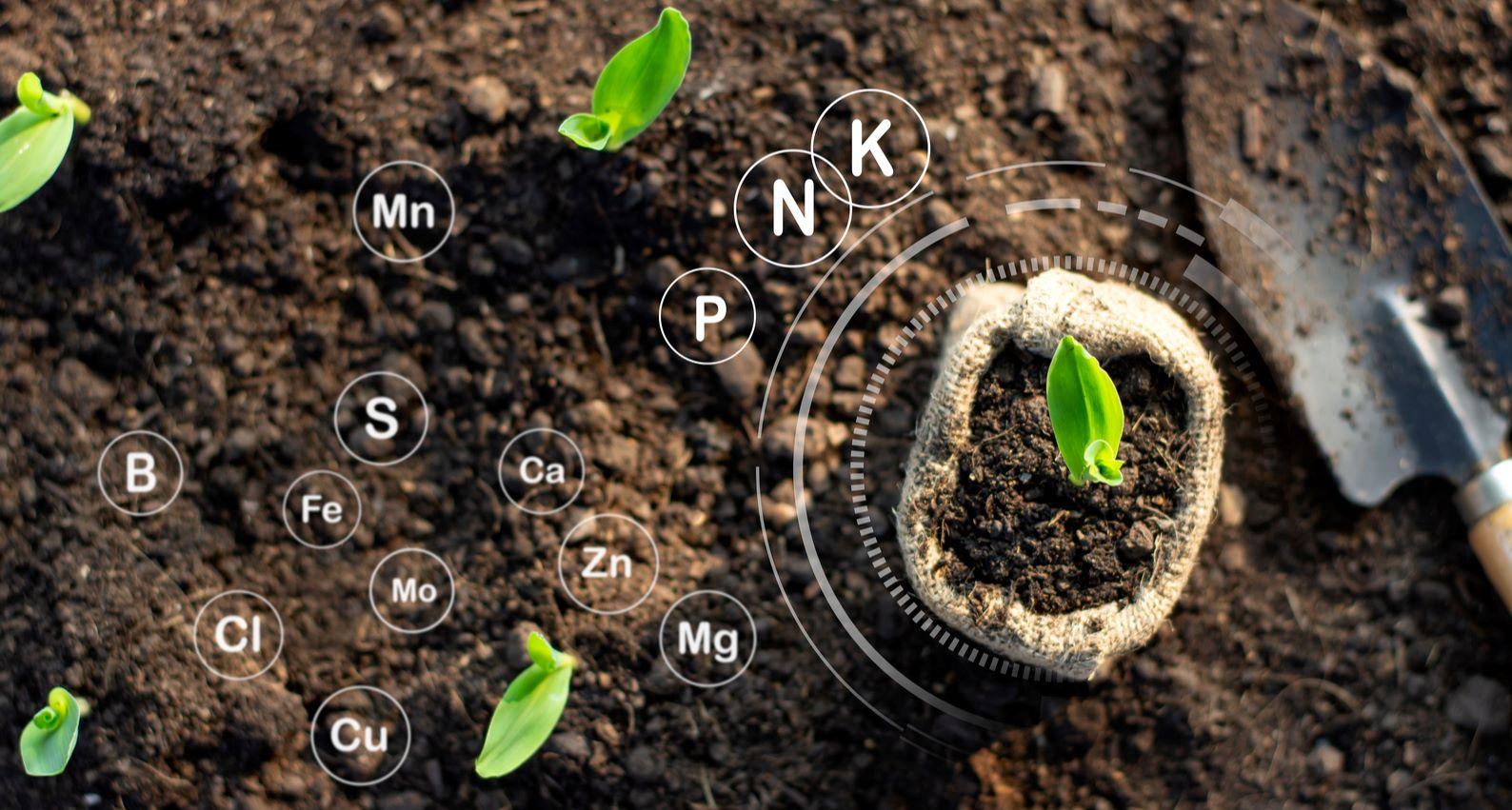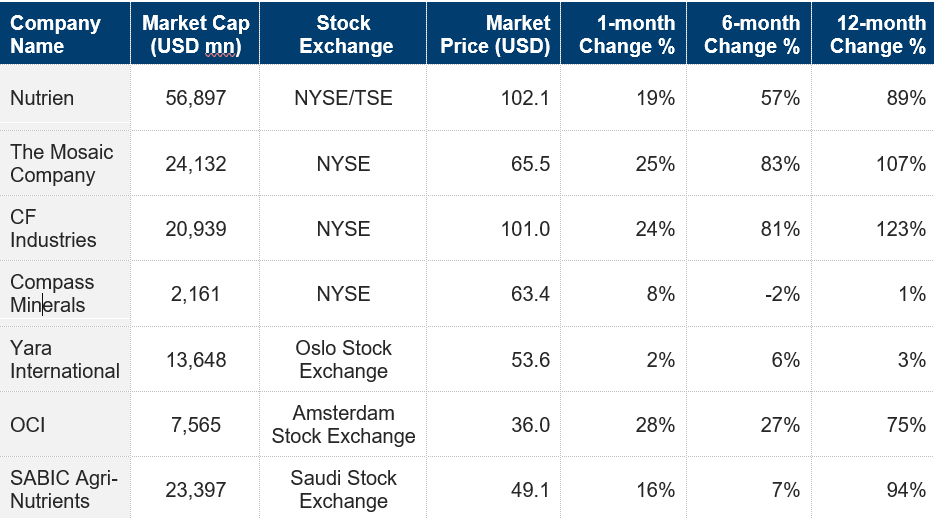Fertilizer Sector on Fertile Ground in 2022
Published on 29 Apr, 2022

Fertilizer prices have considerably increased over the last year. Growth was driven by higher demand on account of economic recovery in 2021 after the pandemic, jump in raw material prices (especially for natural gas), ban on exports by major producers such as Russia and China, and geopolitical tensions.
Fertilizers play a crucial role in meeting food demand and are used worldwide as a supplement providing essential nutrients to crops, thus increasing crop yield. Although they are available naturally, synthetic fertilizers are much widely used due to their easier availability, lower cost, and greater yield. Among these, nitrogen-based fertilizers account for nearly half of the global fertilizer consumption, with the rest made up by phosphate- and potassium-based fertilizers.
The price of fertilizers is determined by macro-economic factors, mainly demand and supply. Demand for fertilizers differs in each country and depends on several factors including population and food production, fertilizer inventory, and farming and application season. Supply depends on a fertilizer company’s capacity and ability to manufacture and sell fertilizers. The cost of raw materials and other overhead charges also impact the manufacturer’s ability and willingness to supply fertilizers to the market. Furthermore, the demand and supply of fertilizers is determined by country-wide policies including export quotas and domestic requirements.
Fertilizer prices reach record high
Fertilizer prices have risen over the last year and continue to follow an upward trajectory. In February 2022, prices of urea went up by 122.1% yoy, muriate of potassium (MOP) by 93.5% yoy and diammonium phosphate (DAP) by 41.3% yoy to USD744/mt, USD392/mt and USD747/mt, respectively.

The rise in demand as opposed to supply shortage had led to the notable hike in fertilizer prices. Demand continued to remain strong after bouncing back from the pandemic-induced slowdown. Moreover, the rise in commodity prices at the start of 2021 prompted farmers to cultivate more crops and boosted demand for fertilizers in 1H21 (vs 2020). However, the shortfall of fertilizers witnessed in 2H21 continues to grow significantly.
High fertilizer manufacturing costs hinder supply
Another reason for the supply shortage was the increasingly high cost of raw materials used to manufacture fertilizers. Natural gas is the key input (feedstock) in producing urea and represents ~80% of the variable cost of production. Globally, the price of natural gas began rising in July 2021 and peaked at USD6.54 (USD/Mbtu) in February 2022.

Source: Bloomberg: World Bank Commodity Prices
The surge in natural gas prices globally was driven by its shortage. Russia fulfils almost 40% of Europe’s natural gas needs. However, in 2021, it failed to meet growing demand in Europe after the pandemic, as Russia reduced exports to the region by 25% in 4Q21 vs 4Q20. The dual energy policy and shortage of power supply led to higher-than-usual demand for natural gas from China as it is making a conscious effort to move away from coal-fired power plants. Moreover, Hurricane Ida that hit the US in August 2021 had a devastating effect on the country’s gas production as several large fertilizer companies had to halt production.
On the other hand, demand for natural gas remained robust globally. Strong demand from Latin America and Asia as well as winter-related demand for heating further boosted natural gas requirement, pushing up its prices.
The prices of other fertilizer raw materials, including nitrogen, nitrates, phosphates, potash and sulphates, rose substantially. The US Producers Price Index for nitrogenous fertilizer climbed up 114% yoy in February 2022 to USD696/mt.

In response to the high cost of production, European fertilizer makers, including Yara International and Borealis, announced production cuts. Yara International stated the output of ammonia and urea at its European facilities would be just 45% of capacity in March 2022, as producing fertilizers at the current high gas price and selling these later may be economically risky. Yara International had earlier implemented similar production cuts in September 2021 due to the burgeoning gas prices in order to maintain its margins.
Profitability for fertilizer companies vary despite high revenues
Riding on the coattails of high product prices, fertilizer manufacturers reported strong Q421 revenues. Manufacturers well equipped to manage their input costs showed good performance, translating high revenues into high profitability. As shown in the chart below, European fertilizer manufacturer Yara International struggled with profitability in 2H21 despite robust revenues, mainly due to high production costs. In contrast, Middle Eastern firms such as SABIC Agri-Nutrients, the fertilizer segment of Industries Qatar and US-based CF Industries recorded significant profits in line with 2H21 revenues as their margins were well managed.

Source: Company websites

Source: Company websites, *CF Industries 3Q21 net income adjusted for asset impairments; **Industries Qatar figure represents segment profit
Analyst expectations and stock prices
With fertilizer prices reaching multi-year highs, analysts have been revising their financial estimates for fertilizer manufactures to reflect the positive momentum of prices on companies’ profitability (illustrated below).

Source: Bloomberg

Source: Bloomberg
Fertilizer companies that optimised the effect of fertilizer prices on their profitability were well appreciated by the market. The stock prices of companies such as SABIC Agri-Nutrients and CF Industries that are operating in favourable market conditions have doubled since a year ago in line with their profitability. Yara International, however, only witnessed a nominal increase in prices, reflecting the negative impact of gas supply shortage in Europe on its business despite higher revenues.

Source: Company Website, Reuters
In addition to individual fertilizer-linked investment ideas, agri-nutrient ETFs are another option for investors to consider.
Current market dynamics limit fertilizer supply amid geopolitical tensions
Russia, China and Canada are the largest fertilizer exporters, together representing 35% of global exports. Russian fertilizer exports accounted for roughly 13% of the global output in 2020. In December 2021, Russia announced restrictions on nitrogen and phosphate fertilizer exports for six months in response to the market situation. Furthermore, after Russia invaded Ukraine in February 2022, several foreign logistics companies suspended cargo shipments to and from Russia in order to comply with the imposed sanctions. In response, the Russian ministry recommended fertilizer producers to temporarily suspend shipments until the logistics carriers resume regular operations and provide guarantees that the exports will be fully completed. The absence of Russian exports has aggravated the already constricted supply of fertilizers.
China also suspended fertilizer exports until June 2022 to ensure domestic availability. As the country exports considerable quantities of DAP and urea, their absence has made the supply situation worse.
Belarus contributed ~18% to global potash production in 2020 through its state-owned arm JSC Belaruskali. The US, UK, EU and Canada imposed sanctions on Belarus in December 2021 as a punitive action against human rights violations, which created a migrant crisis at Belarusian borders. In March 2022, the sanctions were significantly expanded due to Belarus’ role in supporting Russia in the ongoing conflict with Ukraine, further tightening fertilizer supply.
In light of the geopolitical tensions with Russia, the initiation of the new Nord Stream 2 pipeline laid to supply Russian gas to Germany (completed in September 2021) is uncertain.
Thus, the current market dynamics provide a favourable ground for fertilizer prices to stay buoyant in the near term. However, there could be a risk of price correction in fertilizers if natural gas prices normalise sooner than expected, thereby lowering manufacturing costs. Additional capacities of fertilizers scheduled to go onstream in 2022 could potentially increase market supply and exert downward pressure on prices.
Fertilizer manufacturers that control their production levels, exports, pricing, and costs base efficiently would be well positioned to maximise profitability amid exponentially high prices.
